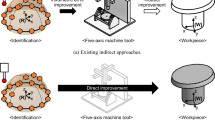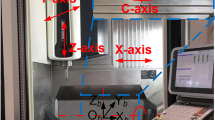Abstract
It is essential to identify spindle axis parallelism errors because such errors trigger volumetric errors when tools of different lengths are used. However, only a few works have addressed this issue. Thus, we identified the inherent spindle axis parallelism errors of machine tools relative to the end-point reference straight line of the Z-axis (according to ISO 230-1) using a dual difference method. Here, “inherent” refers to parallelism errors of the spindle axis that are not affected by the geometric errors of other axes controlled during the measurements, and “dual difference” refers to the difference in the differences of measuring data. The dual difference method uses two pairs of circular tests performed with the aid of a double ball-bar (DBB); the tool lengths differ during each test and the DBB set-up is shared by the pairs. Parallelism errors are then identified based on the dual differences within and between the two pairs. Experimentally, the maximum peak-to-valley (PV) values were 54.5 and 48.7 μm for differences in radial deviations within the two pairs when the parallelism errors were not compensated. After tool-center-point compensation by the identified errors, the PV values improved to 8.0 and 9.2 μm, respectively, showing that compensation was successful. In addition, the concentricity of two holes machined using tools of different lengths improved from 31.2 μm without compensation to 15.9 μm with compensation, further demonstrating the effectiveness of the method.






Similar content being viewed by others
Abbreviations
- l i :
-
Offset (i = 1, …, 3), mm.
- n i :
-
Number of samples during the i-th circular test (i = 1, …, 4).
- s ij :
-
Squareness error of the j axis around the i direction (i, j = x, y, z), rad.
- p xs, p ys :
-
Parallelism errors of the spindle axis around the x and y directions, respectively, rad.
- δ ij :
-
Positional error of the j axis in the i direction (i, j = x, y, z), mm.
- εij :
-
Angular error of the j axis around the i direction (i, j = x, y, z), rad.
- θ j :
-
Rotation angle during the circular test (j = 1, …, ni), rad.
- R :
-
Nominal length of the double ball-bar, mm.
- ΔR ij :
-
j- th measured radial deviation during the i-th circular test (i = 1, …, 4; j = 1, …, ni), mm.
- (w xi, w yi, w zi):
-
Set-up errors of a ball on a workpiece table in the x, y, and z directions, respectively, during the i-th circular test, (i = 1, …, 4), mm.
- (0, 0, t i):
-
Nominal coordinate of a ball at the tool nose in the spindle coordinate system {S} during the i-th circular test, (i = 1, …, 4), mm.
- (0, 0, h i):
-
Nominal coordinate of a ball on a workpiece table in the workpiece coordinate system {W} during the i-th circular test, (i = 1, …, 4), mm.
- (x, y, z):
-
Nominal commands of the X, Y, and Z axes, respectively, mm.
- { i } :
-
Coordinate system of axis i, (i = X, Y, Z).
- { R }, { W }, { S }, { t } :
-
Coordinate systems of the reference, workpiece, spindle, and tool, respectively.
- \({{\varvec{\uptau}}}_{i}^{j}\) :
-
4 × 4 Homogeneous transformation matrix from the j coordinate system to the i coordinate system.
References
Yang, S. H., & Lee, K. I. (2021). Machine tool analyzer: A device for identifying 13 position–independent geometric errors for five–axis machine tools. The International Journal of Advanced Manufacturing Technology, 115, 2945–2957. https://doi.org/10.1007/s00170-021-07341-7
Lee, K. I., & Yang, S. H. (2013). Measurement and verification of position–independent geometric errors of a five–axis machine tool using a double ball–bar. International Journal of Machine Tools and Manufacture, 70, 45–52. https://doi.org/10.1016/j.ijmachtools.2013.03.010
ISO 230–1. (2012). Test code for machine tools – Part 1: Geometric accuracy of machines operating under no–load or quasi–static conditions. ISO.
ISO 230–7. (2015). Test code for machine tools – part 7: Geometric accuracy of axes of rotation. ISO.
Schwenke, H., Knapp, W., Haitjema, H., Weckenmann, A., Schmitt, R., & Delbressine, F. (2008). Geometric error measurement and compensation of machines–An update. CIRP Annals, 57, 660–675. https://doi.org/10.1016/j.cirp.2008.09.008
Ibaraki, S. & Knapp, W. (2012). Indirect measurement of volumetric accuracy for three–axis and five–axis machine tools: A review. International Journal of Automation Technology, 6: 110–124. https://doi.org/10.20965/ijat.2012.p0110
ISO 230–2. (2014). Test code for machine tools – part 2: Determination of accuracy and repeatability of positioning of numerically controlled axes. ISO.
Liu, H., Yang, R., Wang, P., Chen, J., Xiang, H., & Chen, G. (2020). Measurement point selection and compensation of geometric error of NC machine tools. The International Journal of Advanced Manufacturing Technology, 108, 3537–3546. https://doi.org/10.1007/s00170-020-05411-w
Wang, Z., Wang, D., Wu, Y., Dong, H., & Yu, S. (2021). An invariant approach replacing Abbe principle for motion accuracy test and motion error identification of linear axes. International Journal of Machine Tools and Manufacture, 166, 103746. https://doi.org/10.1016/j.ijmachtools.2021.103746
ISO 230–4. (2005). Test code for machine tools part 4: Circular tests for numerically controlled machine tools. ISO.
Wang, Z., Wang, D., Yu, S., Li, X., & Dong, H. (2021). A reconfigurable mechanism model for error identification in the double ball bar tests of machine tools. International Journal of Machine Tools and Manufacture, 165, 103737. https://doi.org/10.1016/j.ijmachtools.2021.103737
ISO 203–6. (2002). Test code for machine tools – part 6: Determination of positioning accuracy on body and face diagonals (diagonal displacement tests). ISO.
Yang, S. H., Lee, H. H., & Lee, K. I. (2019). Identification of inherent position-independent geometric errors for three-axis machine tools using a double ballbar with an extension fixture. The International Journal of Advanced Manufacturing Technology, 102, 2967–2976. https://doi.org/10.1007/s00170-019-03409-7
ISO/TR 230–11. (2018). Test code for machine tools – part 11: Measuring instruments suitable for machine tool geometry tests. ISO.
ISO 10791–1. (2015). Test conditions for machining centres part 1: Geometric tests for machines with horizontal spindle (horizontal Z-axis). ISO.
ISO 10791–2. (2001). Test conditions for machining centres part 2: Geometric tests for machines with vertical spindle or universal heads with vertical primary rotary axis. ISO.
Lee, K. I., Shin, D. H., & Yang, S. H. (2017). Parallelism error measurement for the spindle axis of machine tools by two circular tests with different tool lengths. The International Journal of Advanced Manufacturing Technology, 88, 2883–2887. https://doi.org/10.1007/s00170-016-8999-0
Yang, S. H., Lee, D. M., Lee, H. H., & Lee, K. I. (2020). Sequential measurement of position-independent geometric errors in the rotary and spindle axes of a hybrid parallel kinematic machine. International Journal of Precision Engineering and Manufacturing, 21, 2391–2398. https://doi.org/10.1007/s12541-020-00437-2
Dassanayake, K. M. M., Tsutsumi, M., & Saito, A. (2006). A strategy for identifying static deviations in universal spindle head type multi-axis machining centers. International Journal of Machine Tools and Manufacture, 46, 1097–1106. https://doi.org/10.1016/j.ijmachtools.2005.08.010
ISO/IEC Guide 98–3. (2008). Uncertainty of measurement – part 3: Guide to the expression of uncertainty in measurement (GUM:1995). ISO.
ISO 230–9. (2005). Test code for machine tools – part 9: Estimation of measurement uncertainty for machine tool tests according to series iso 230, basic equations. ISO.
Ibaraki, S., & Hiruya, M. (2021). A novel scheme to measure 2D error motions of linear axes by regulating the direction of a laser interferometer. Precision Engineering, 67, 152–159. https://doi.org/10.1016/j.precisioneng.2020.09.011
Yang, S. H., & Lee, K. I. (2021). Identification of 11 position–independent geometric errors of a five–axis machine tool using 3D geometric sensitivity analysis. The International Journal of Advanced Manufacturing Technology, 113, 3271–3282. https://doi.org/10.1007/s00170-021-06844-7
Lee, D. M., & Yang, S. H. (2010). Mathematical approach and general formulation for error synthesis modeling of multi-axis system. International Journal of Modern Physics B, 24, 2737–2742. https://doi.org/10.1142/S0217979210065556
Lee, K. I., & Yang, S. H. (2013). Robust measurement method and uncertainty analysis for position-independent geometric errors of a rotary axis using a double ball-bar. International Journal of Precision Engineering and Manufacturing, 14, 231–239. https://doi.org/10.1007/s12541-013-0032-z
Acknowledgements
This work was supported by the National Research Foundation of Korea (NRF) grant funded by the Korea government (MSIT) (Nos. 2020R1C1C100330011, 2019R1A2C2088683).
Funding
This work was supported by the National Research Foundation of Korea(NRF) grant funded by the Korea government(MSIT) (No. 2020R1C1C100330011, 2019R1A2C2088683).
Author information
Authors and Affiliations
Corresponding author
Ethics declarations
Conflict of interest
The authors declare that they have no conflict of interest.
Additional information
Publisher's Note
Springer Nature remains neutral with regard to jurisdictional claims in published maps and institutional affiliations.
Rights and permissions
About this article
Cite this article
Yang, SH., Lee, KI. A Dual Difference Method for Identification of the Inherent Spindle Axis Parallelism Errors of Machine Tools. Int. J. Precis. Eng. Manuf. 23, 701–710 (2022). https://doi.org/10.1007/s12541-022-00653-y
Received:
Revised:
Accepted:
Published:
Issue Date:
DOI: https://doi.org/10.1007/s12541-022-00653-y




